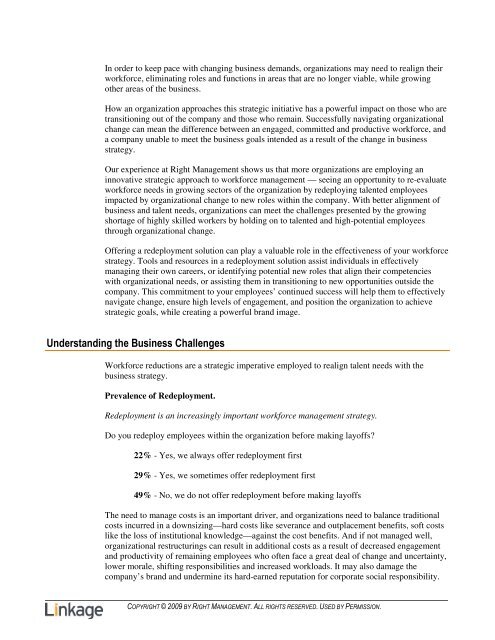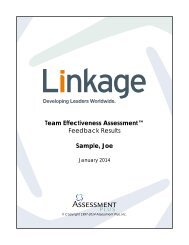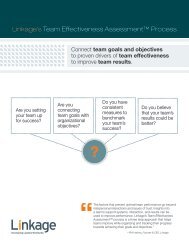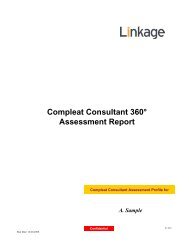Redeployment: Connecting Talent to Organizational Workforce Needs
Redeployment: Connecting Talent to Organizational Workforce Needs
Redeployment: Connecting Talent to Organizational Workforce Needs
You also want an ePaper? Increase the reach of your titles
YUMPU automatically turns print PDFs into web optimized ePapers that Google loves.
In order <strong>to</strong> keep pace with changing business demands, organizations may need <strong>to</strong> realign their<br />
workforce, eliminating roles and functions in areas that are no longer viable, while growing<br />
other areas of the business.<br />
How an organization approaches this strategic initiative has a powerful impact on those who are<br />
transitioning out of the company and those who remain. Successfully navigating organizational<br />
change can mean the difference between an engaged, committed and productive workforce, and<br />
a company unable <strong>to</strong> meet the business goals intended as a result of the change in business<br />
strategy.<br />
Our experience at Right Management shows us that more organizations are employing an<br />
innovative strategic approach <strong>to</strong> workforce management — seeing an opportunity <strong>to</strong> re-evaluate<br />
workforce needs in growing sec<strong>to</strong>rs of the organization by redeploying talented employees<br />
impacted by organizational change <strong>to</strong> new roles within the company. With better alignment of<br />
business and talent needs, organizations can meet the challenges presented by the growing<br />
shortage of highly skilled workers by holding on <strong>to</strong> talented and high-potential employees<br />
through organizational change.<br />
Offering a redeployment solution can play a valuable role in the effectiveness of your workforce<br />
strategy. Tools and resources in a redeployment solution assist individuals in effectively<br />
managing their own careers, or identifying potential new roles that align their competencies<br />
with organizational needs, or assisting them in transitioning <strong>to</strong> new opportunities outside the<br />
company. This commitment <strong>to</strong> your employees’ continued success will help them <strong>to</strong> effectively<br />
navigate change, ensure high levels of engagement, and position the organization <strong>to</strong> achieve<br />
strategic goals, while creating a powerful brand image.<br />
Understanding the Business Challenges<br />
<strong>Workforce</strong> reductions are a strategic imperative employed <strong>to</strong> realign talent needs with the<br />
business strategy.<br />
Prevalence of <strong>Redeployment</strong>.<br />
<strong>Redeployment</strong> is an increasingly important workforce management strategy.<br />
Do you redeploy employees within the organization before making layoffs<br />
22% - Yes, we always offer redeployment first<br />
29% - Yes, we sometimes offer redeployment first<br />
49% - No, we do not offer redeployment before making layoffs<br />
The need <strong>to</strong> manage costs is an important driver, and organizations need <strong>to</strong> balance traditional<br />
costs incurred in a downsizing—hard costs like severance and outplacement benefits, soft costs<br />
like the loss of institutional knowledge—against the cost benefits. And if not managed well,<br />
organizational restructurings can result in additional costs as a result of decreased engagement<br />
and productivity of remaining employees who often face a great deal of change and uncertainty,<br />
lower morale, shifting responsibilities and increased workloads. It may also damage the<br />
company’s brand and undermine its hard-earned reputation for corporate social responsibility.<br />
COPYRIGHT © 2009 BY RIGHT MANAGEMENT. ALL RIGHTS RESERVED. USED BY PERMISSION.
















